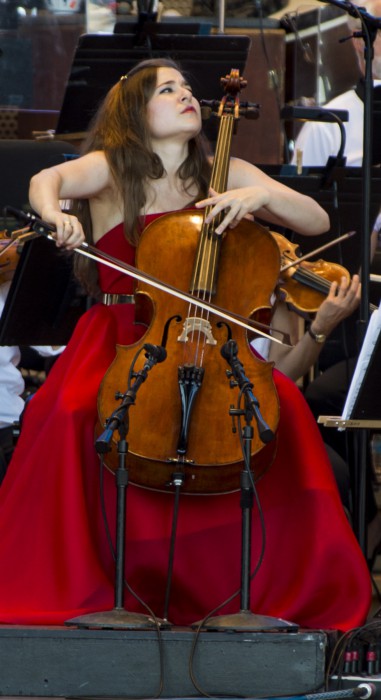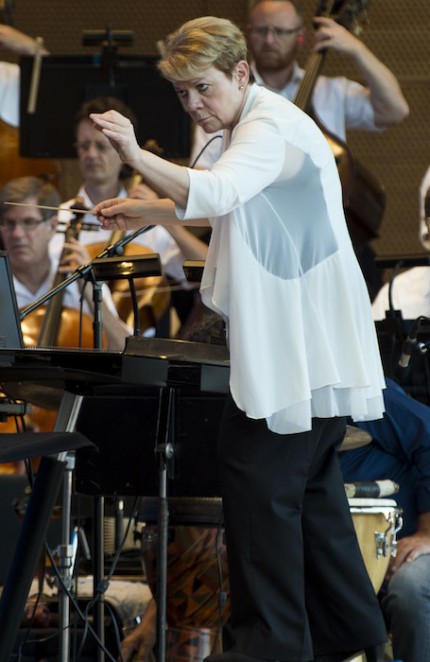Grant Park Orchestra program offers piquant blend of music and nature

All too rarely do outdoor concerts take advantage of being outdoors. Often the music competes (to its detriment) with the sounds of nature.
But Wednesday night’s Grant Park Music Festival program was smartly chosen to work with its surroundings. Marin Alsop led the Grant Park Orchestra in the sky-themed Azul by Argentinian composer Osvaldo Golijov and in the earth-themed Life: A Journey Through Time by Philip Glass at the Pritzker Pavilion.
Azul is something of a latter-day concerto grosso, whose astronomical theme was inspired by Golijov’s visit to the Hayden Planetarium in New York (according to the program notes) or to watching the stars while listening to music on the Tanglewood lawn (according to the composer’s spoken remarks). Its four solo parts are for cello, hyperaccordion, and two percussionists playing an astounding array of instruments. Star cellist Alisa Weilerstein was primus inter pares, with Michael Ward-Bergeman, James Haddad, and Cyro Baptista, respectively, backing her up.
(If you have not heard of a hyperaccordion before, that is probably because Ward-Bergeman invented the instrument. It is to the accordion what a sophisticated electric keyboard is to the piano. In fact, if you closed your eyes, at most points you would have mistaken the instrument for either an ordinary accordion or a synthesizer.)
The piece’s outer movements are like a creature crying out in a vast wilderness. The middle section begins hypnotically, and ends in cataclysm, which Alsop and the orchestra played with the thunder of a Mahlerian march. The third movement features just the soloists, with the cello playing arpeggiated figures reminiscent of a Bach prelude, while the percussionists conjure various global music traditions.
All four soloists played their parts well, with Weilerstein the standout for her plangent but clear tone. Alsop and the orchestra delivered on the piece’s wide variety of timbres, particularly the brasses, who brayed at the conclusion in a moment the composer likened to stars shooting across the skies.
If Azul has a liability, it is that it wishes to speak spiritual sentiments in a language that has been co-opted too successfully by Hollywood soundtracks. This can leave it rather earthbound, in spite of its obvious craftsmanship.
What helped alleviate this was the setting of the concert and the al fresco contributions. At times it was hard to tell: Were those sounds of real birds or bird calls played by the percussionists? Was that rumble from the streets or in the basses? The music and the sense of space seemed to fuse into a unified entity, in a way that could not have better served the piece.
The sights and sounds of real birds also dovetailed effectively with the other piece on the program: Life: A Journey Through Time, a multimedia piece marrying the nature pictures of National Geographic photographer Frans Lanting with the music of Philip Glass. Alsop and the orchestra played four of the original seven movements of the piece: the fifth, third, second, and seventh movements (in that order).
Of course, Lanting and Glass’s styles are known quantities, and both are shown at their best in this piece. The question is whether they cohere.
At first blush, the pairing is an odd one. Lanting’s photos derive much of their power from the intensity of their colors: orange petals and feathers that glow like lava, skies and seas that seem too blue to be real. Glass’s music is much the opposite. It is built on commonplace chord progressions whose very colorlessness is part of their pretext, so that their elevation through the hypnosis of repetition can seem like wizardry.
At times this disconnect between the visuals and Glass’s music was evident, symptomatic of the fact that the music and images were created for separate purposes. (The music is drawn from Glass’s Orion, his opera Les Enfants Terribles, and the score to the film, The Man in the Bath.)
The music in “Beginnings” (depicting the beginning of life in the ocean) grows more active over its course, but otherwise does little to suggest the origins of life. “Into the Air” (focusing on birds and flowers) is supposed to end with a mass extinction, but you wouldn’t know that without reading the program.
But at other times, the images and music worked well together, with musical color supplied by Michael Riesman’s orchestral arrangements. “Into the Air” truly took flight thanks to the majestic sweep Alsop and the orchestra gave to Riesman’s orchestrations. And the finale “Planet of Life” (in which all the different forms of life reappear) danced with rollicking vigor in their hands.
Much credit is also due to Alexander V. Nicholas, the piece’s “visual choreographer.” At times, the photographs “dance” in coordination with specific musical cues, timed precisely by Alsop: timpani strokes in the second movement or woodwind and celesta flourishes in the third. But elsewhere, the sense of motion and coordination is subtler, and the photographs speak more clearly for themselves, with music enhancing rather than dictating.
Marin Alsop and the Grant Park Orchestra are joined by jazz violinist Regina Carter in the music of James P. Johnson and Duke Ellington, along with Dvorak’s Symphony No. 9 (“From the New World”) 6:30 p.m. Friday and 7:30 p.m. Saturday in the Pritzker Pavilion. grantparkmusicfestival.com
Posted in Performances





